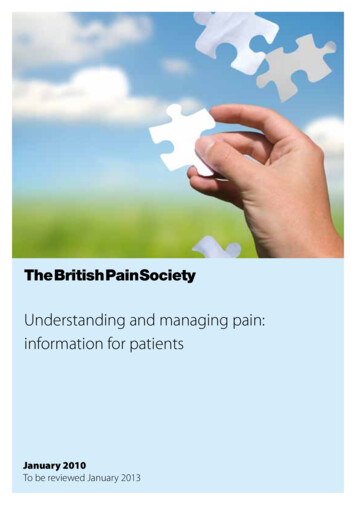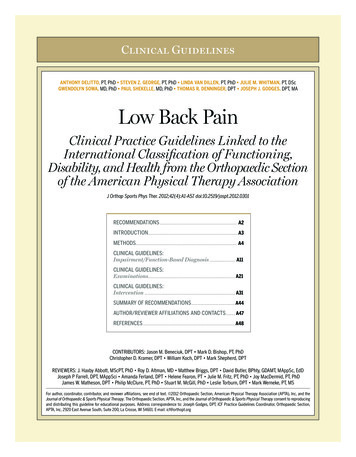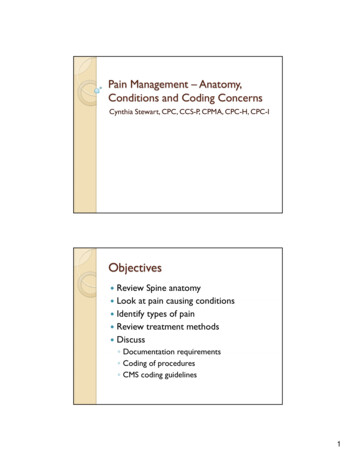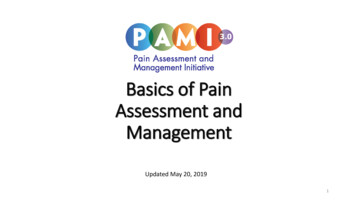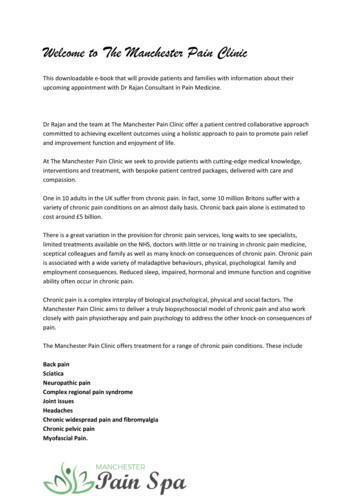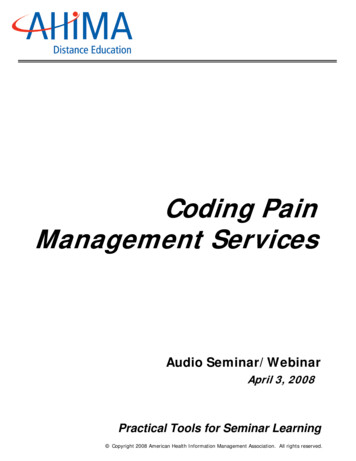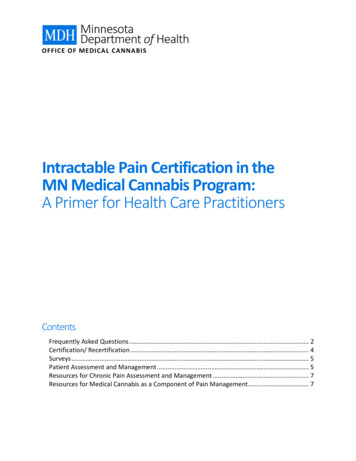
Transcription
OFFICE OF MEDICAL CANNABISIntractable Pain Certification in theMN Medical Cannabis Program:A Primer for Health Care PractitionersContentsFrequently Asked Questions . 2Certification/ Recertification . 4Surveys . 5Patient Assessment and Management . 5Resources for Chronic Pain Assessment and Management . 7Resources for Medical Cannabis as a Component of Pain Management. 7
INTRACTABLE PAIN CERTIFICATION IN THE MN MEDICAL CANNABIS PROGRAMFrequently Asked Questions1. What is the program’s definition of “intractable pain”?At time of certification (and recertification) the certifying health care practitioner must check abox indicating the following:“I certify that this patient has intractable pain. That is, this patient has pain whose causecannot be removed and, according to generally accepted medical practice, the full range ofpain management modalities appropriate for this patient has been used without adequateresult or with intolerable side effects.”2. Does the Office of Medical Cannabis require certain treatments for“intractable pain”?The Office of Medical Cannabis does not require particular therapeutic modalities for specificpatients. Instead, it relies on the professional judgement of the health care practitioner toassess pain management therapies already used and then to develop, in consultation with thepatient, a comprehensive paint management plan going forward.3. Do opioid medications need to be tried before meeting the definitionof “intractable pain”?The Office of Medical Cannabis relies on the professional judgment of the certifying health carepractitioner as to whether the full range of treatment approaches appropriate for an individualpatient have been sufficiently used to meet the program’s definition of intractable pain. It isnot required that opioid medications be tried before meeting the definition of intractable pain,because opioid medications are not appropriate for some patients with chronic pain.4. Are there limitations on the types of pain that are included?Certification is not limited to certain types or causes of pain. However, the certifying healthcare practitioner must acknowledge that the patient meets the program’s definition ofintractable pain (see above).5. Is consultation with a pain management specialist required? Is asecond opinion required?Consultation with a pain management specialist is not required. A second opinion is notrequired.2
INTRACTABLE PAIN CERTIFICATION IN THE MN MEDICAL CANNABIS PROGRAM6. Are there certain things I need to include in medical recorddocumentation?Your documentation should include: History, physical findings, and results of imaging and laboratory studies relevant to the paincondition,Results of pain management strategies already used by the patient and their effectivenessand tolerability – in sufficient detail to justify the program’s definition of intractable pain,The patient’s comprehensive pain management plan going forward,And the patient’s treatment course after he or she started using medical cannabis.The MN Department of Health has the authority to request medical records for severalpurposes, including validating compliance with program requirements.3
INTRACTABLE PAIN CERTIFICATION IN THE MN MEDICAL CANNABIS PROGRAMCertification/RecertificationWhen certifying or re-certifyingpatients for intractable pain,you will answer three additionalpain related questions.These questions ask you to dothe following:1. Acknowledge that thepatient meets the program’sdefinition of intractablepain,2. Indicate the medicalcondition that is the primarycause of the pain,3. Indicate what pain ratingscale you will use to followthe patient’s pain over timeand the date and score ofthe most recent assessment1. Acknowledge that the patient meets theprogram’s definition of intractable pain.There is a check box indicating agreement with thefollowing:“I certify that this patient has intractable pain. That is,this patient has pain, the cause of which cannot beremoved and the full range of pain managementmodalities appropriate for this patient, according togenerally accepted medical practice, has been usedwithout adequate result or with intolerable sideeffects.”The program relies on the professional opinion ofparticipating health care practitioners as to whether therange of treatment approaches used for an individualpatient meet this definition. Use of opioid medications isnot required to meet the definition, as opioid analgesicsare not appropriate for all patients with chronic pain.2. Indicate the medical condition that is theprimary cause of the painTo see the information collectedat certification for all patientsand for detailed information onhow to complete a certification,A drop-down menu of 31 conditions is provided, along withan “Other” option. Choose the one that fits best. If“Other” is selected a free-text field is provided to specify amedical condition different from the available options.Reference Guide PatientRegistry: HCP ics/cannabis/docs/materials/refgu idehcp.pdf3. Indicate what pain rating scale will be usedto follow the patient’s pain over time anddate and score of most recent assessmentSeveral common pain rating scales are provided, plus an“Other” option if the one you plan to use isn’t on the list.We recommend use of the PEG scale because it is short,combining one question on pain intensity and two onlimitation of function but clinicians are free to use the scaleof their choice. This question on pain scale score and dateis asked at certification/recertification and on a surveyconducted by the Office of Medical Cannabis six monthsafter certification/recertification.PEG 3 Item Pain Scale intractable/PEG pain scale.pdf4
INTRACTABLE PAIN CERTIFICATION IN THE MN MEDICAL CANNABIS PROGRAMSurveysShort surveys are a primary sourceof information the Office of MedicalCannabis receives from health careproviders about patients theycertify. These surveys occur every sixmonths. MDH sends an emailnotifying certifying health carepractitioners that a survey is dueand ready to be filled out. Apractitioner can also access surveysthrough his or her provider accounthome page. The home page lists allthe patients the provider hascertified. An “Open Survey” buttonappears for each patient when asurvey is due. Failure to completethe surveys may result in the Officeof Medical Cannabis requesting thepatient’s medical records.The surveys for patients certifiedwith intractable pain contain twoadditional questions compared tothe surveys for other qualifyingconditions.Survey sent six months aftercertification/recertification of apatient for intractable pain:Health Care Practitioner 6mo /docs/intractable/IP180 Days HCP Survey.pdfSurvey sent immediately afterrecertification:Health Care Practitioner s/docs/intractable/IP ReApproval HPC Survey.pdf51. Impact of medical cannabis on otherpain medicationsThis question will be asked on the survey every 6months, starting with the survey 6 months aftercertification:“Over the past 6 months has this patient’s use ofmedical cannabis assisted in reducing dosage oreliminating other medications used for pain?Responses: Yes (specify the change(s) inmedication(s); No; Not Applicable (patient nottaking any medications for pain 6 months ago).We are interested in changes in use of opioids, ofcourse, but also other medications used for painmanagement, including benzodiazepines.2. Date and score of most recent painassessment and pain assessment scaleusedThis is asked at certification and recertification and onthe surveys six months aftercertification/recertification (see description aboveunder “Certification/Recertification”).Patient Assessment and ManagementThe Office of Medical Cannabis does not requireparticular therapeutic modalities for specific patients.Instead, it relies on the professional judgement of thehealth care practitioner to assess and documentresults of a comprehensive pain management strategyused by the patient – in sufficient detail to justify theprogram’s definition of intractable pain. The Office ofMedical Cannabis expects the certifying clinician tohave an ongoing role in managing the patient’s painand to document the patient’s treatment course afterhe or she started using medical cannabis. The MNDepartment of Health has the authority to requestmedical records for several purposes, includingvalidating compliance with program requirements.
INTRACTABLE PAIN CERTIFICATION IN THE MN MEDICAL CANNABIS PROGRAMA few aspects of patient assessmentand management worthemphasizing include the following: Use of medical cannabis beforethe full range of treatmentmodalities appropriate for thepatient have been used –without adequate effect or withintolerable side effects – is notconsistent with the rules of theprogram,Use of opioid medications is notrequired to meet the program’sdefinition of intractable pain,since opioid medications areoften not appropriate forpatients with chronic pain.Key aspects of high quality,comprehensive chronic painassessment and management areoutlined below, derived from theInstitute for Clinical SystemsImprovement (ICSI) 2013 Guidelinefor Assessment and Management ofChronic Pain. The guideline is a richresource of information, includingreferences to an extensivebibliography, for these topicsICSI, Pain, Chronic; Assessment andManagement ofhttp://www.icsi.org/guidelines more/catalog guidelines and more/catalog guidelines/catalog pain guidelines/pain chronic/6Assessment Use validated tools to assess pain and functionDetermine pain generator, including nerve andtissue damageOpioid status and historyPsychological impact of pain and potentialpresence of concomitant psychiatric diseaseScreen for substance use disordersDiscussion with patient about their expectationsComprehensive, MultidisciplinaryTreatment Plan Engage with the patient to develop realistic goalsand expectationsDevelop and document a comprehensive,multidisciplinary treatment plan including thefollowing, unless deemed inappropriate for aparticular patient: Physical modalities and rehabilitation Complementary treatment modalities Behavioral health/Psychological management Pharmacotherapy Interventional proceduresFollow-Up Set into motion the initial components of thetreatment planCommunicate with and/or examine the patient atsufficient intervals to determine responseDocument results and input from referral sourcesProceed with other aspects of the treatment plan,revising plan as needed
INTRACTABLE PAIN CERTIFICATION IN THE MN MEDICAL CANNABIS PROGRAMResources for Chronic Pain Assessment and ManagementThe Institute for Clinical Systems Improvement (ICSI) developed a guideline for assessment andmanagement of chronic pain, released late in 2013. ICSI is now in the process of producing anupdated comprehensive pain management guideline. The currently available guideline is anexcellent resource for information on chronic pain assessment and management and it includesreferences to an extensive bibliography. This guideline and a library of ICSI’s publicly availableguidelines can be accessed through the ICSI website https://www.icsi.org/ICSI, Pain, Chronic; Assessment and Management ofhttp://www.icsi.org/guidelines more/catalog guidelines and more/catalog guidelines/catalog pain guidelines/pain chronic/Resources for Medical Cannabis as a Componentof Pain ManagementMEDICAL CANNABIS FOR NON-CANCER PAIN: A SYSTEMATIC REVIEW; OCTOBER, 2015.The Minnesota Department of Health contracted with the Minnesota Evidence-based PracticeCenter to do a systematic literature review and grading of evidence on cannabis use for treatingchronic non-cancer pain. This is the report resulting from that effort, released in early October,2015. It can be accessed on the MDH Office of Medical Cannabis web site ntractable/medicalcannabisreport.pdfA REVIEW OF MEDICAL CANNABIS STUDIES RELATING TO CHEMICAL COMPOSITIONS ANDDOSAGES FOR QUALIFYING MEDICAL CONDITIONS; MAY, 2016.This report summarizes clinical trials and prospective observational studies in humans,published in peer-reviewed journals that focus on the Minnesota medical cannabis program’squalifying conditions and on medical cannabis formulations consistent with the program’sspecifications. It was originally produced in December, 2014 and it is periodically updated toinclude more recent articles and newly-added qualifying conditions. The update produced inMay, 2016 contains summaries of clinical trials of medical cannabis for treating chronic noncancer pain. This report can be accessed on the MDH Office of Medical Cannabis web site DELINES DEVELOPED BY PROFESSIONAL ASSOCIATIONS AND HEALTH AGENCIESAttal N, Cruccu G, Baron R, Haanpaa M, Hansson P, Jensen TS, Numikko T. EuropeanFederation of Neurological Societies Guidelines on the pharmacological treatment ofneuropathic pain. 2010 revision. Eur J Neurol. 2010;17:1113-e88. doi: 10.1111/j.14681331.2010.02999.x. Epub 2010 Apr 9. Review.Update of 2006 guidelines based on review of strength of RCTs. Recommendations divided intocommon types of neuropathic pain, including diabetic, post-herpetic, classical trigeminalneuralgia, central pain (MS, post-stroke, spinal cord injury), HIV, post-traumatic/post-surgical,chronic radiculopathy, cancer, phantom pain, and mixed-etiology neuropathic pain.Cannabinoids mentioned for only two types of neuropathic pain. Cannabinoids recommended7
INTRACTABLE PAIN CERTIFICATION IN THE MN MEDICAL CANNABIS PROGRAMin MS only if all other treatments fail. Cannabinoids mentioned as having evidence ofinefficacy/poor efficacy or discrepant results for use in post-traumatic or post-surgical NP, andnot recommended for use.Moulin D, Boulanger A, Clark, et al. Pharmacological management of chronic neuropathicpain: Revised consensus statement from the Canadian Pain Society. Pain Res Manag.2014;19:328-335.The Canadian Pain Society developed its first guideline on pharmaceutical management ofneuropathic pain (NeP) in 2007. This guideline update is based on systematic review andgrading of trial literature and the work of a consensus committee. “The current guidelines arebased on quality of evidence of analgesic efficacy, side-effect profiles and ease of use.Medications were considered to be first line if there was a high-quality evidence of efficacy (atleast one class I study or two consistent class II studies- level of recommendation Grade B orbetter; positive results in at least two NeP models; and if they were considered to bestraightforward and of sufficient tolerability to prescribe and monitor. Medications wereconsidered to be second or their line if there was high-quality evidence of efficacy, but themedication required more specialized follow-up and monitoring. Fourth-line treatments had atleast one positive RCT, but require further study. A limitation of this algorithmic classification isthe grading of tolerability and ease of use was based solely on consensus opinion of theauthors.” “The cannabinoids have now advanced to third-line agents in the management ofchronic NeP based on increasing evidence of efficacy in multiple pain models including HIVneuropathy, post-traumatic postsurgical NeP, painful diabetic neuropathy and spinal cord injurypain (Lynch 2011; Toth 2012). However, the cannabinoids also require close monitoring, arecontraindicated in patients with a history of psychosis and most of these agents, including theoral mucosal spray, are expensive.”Neuropathic Pain: The pharmacological management of neuropathic pain in adult in nonspecialist settings. Centre for Clinical Practice at NICE (UK). 2013. National Institute for Healthand Clinical Excellence Guidance.“There is some evidence that cannabis sativa decreases pain compared with placebo, but in theanalyses it appeared consistently worse than other treatments at reducing pain.” Following is asummary of the recommendations regarding “All neuropathic pain”. “Offer a choice ofamitriptyline, duloxetine, gabapentin or pregabapentin as initial treatment for neuropathic pain(except trigeminal neuralgia); if the initial treatment is not effective or is not tolerated, offerone of the remaining 3 drugs, and consider switching again if the second and third drugs triedare also not effective or not tolerated; consider tramadol only if acute rescue therapy isneeded; consider capsaicin cream for people with localized neuropathic pain who wish to avoid,or who cannot tolerate, oral treatments; do not start the following to treat neuropathic pain innon-specialist settings, unless advised by a specialist to do so (“cannabis sativa extract” is onthis list of 10 medications, which also includes morphine). In their review of literature,regarding cannabinoids, they list Nurmikko (2007); Rog (2005); Selvarrajah (2010), and Wade(2004). Regarding peripheral neuropathic pain, “There is some evidence that cannabis sativaand capsaicin patch reduce pain compared with placebo but both drugs appeared consistentlyworse at reducing pain than other drugs.” Regarding Central NP: “Low and very-low qualityevidence from 2 small studies suggests that cannabis sativa and duloxetine may be better thanplacebo at follow-up periods of less than 12 weeks. However, confidence in the results is low8
INTRACTABLE PAIN CERTIFICATION IN THE MN MEDICAL CANNABIS PROGRAM ” “Low quality evidence from 2 studies shows that cannabis sativa may be better thanplacebo at improving sleep at 4 weeks and pregabalin may be better than placebo at improvingsleep at 12 weeks, but it is not clear if this is clinically significant.”Review articles and opinion piecesAggarwal SK. Cannabinergic pain medicine: A concise clinical primer and survey ofrandomized-controlled trial results. Clin J Pain 2013;29:162-171.This article attempts to cover a lot of content in just 6 pages. It includes 121 references, so itgives plenty of leads for those who want to pursue topics in more depth.Bostwick JM. The use of cannabis for management of chronic pain. Gen Hosp Psychiatry.2014;36:2-3.Short, lively opinion piece that covers many of the observations regarding medical cannabis andpain that appear in “PRO” opinion pieces on the subject. Bostwick is a Mayo psychiatrist.D’Souza DC and Ranganathan M. Medical marijuana: Is the cart before the horse? JAMA.2015;313:2431-2432.This editorial covers many of the observations regarding medical cannabis and pain that appearin “CON” opinion pieces on the subject. Both authors are Yale psychiatrists.Elikottil J, Gupta P, Gupta K. The analgesic potential of cannabinoids. J Opioid Manag2009;5:341-357.This paper presents a good brief history of medical use of cannabis, and detailed discussions ofthe different types of cannabinoids and pain-related cannabinoid receptors and signalingpathways. Animal studies of cannabinoids for anesthesia in neuropathic, inflammatory, andcancer pain are described. Approximately 20 clinical trials of cannabinoids in multiple sclerosis,neuropathic, and non-neuropathic pain populations are summarized and discussed.Hill KP. Medical marijuana for treatment of chronic pain and other medical and psychiatricproblems: A clinical review. JAMA 2015;313:2474-2483.A literature review and case presentation based on a Grand Rounds conference at Beth IsraelDeaconess Medical Center, Boston, in May, 2014. The patient discussed is a 60 year old withback pain since a fall 19 years ago and extensive surgical and medical treatment for pain sincethen. From the FINDINGS section of the abstract, “Use of marijuana for chronic pain,neuropathic pain, and spasticity due to multiple sclerosis is supported by high-quality evidence.Six trials that included 325 patients examined chronic pain, 6 trials that included 396 patientsinvestigated neuropathic pain, and 12 trials that included 1600 patients focused on multiplesclerosis. Several of these trials had positive results, suggesting that marijuana or cannabinoidsmay be efficacious for these indications.” Of particular note is the clinical approach toevaluation of a patient for medical cannabis certification, beginning on page 2478 andsummarized in a box on page 2480.9
INTRACTABLE PAIN CERTIFICATION IN THE MN MEDICAL CANNABIS PROGRAMRusso EB, Guy GW, Robson PJ. Cannabis, pain, and sleep: Lessons from therapeutic clinicaltrials of Sativex , a cannabis-based medicine. Chemistry and Biodiversity 2007;4:1729-1743.This article reviews evidence of effect of THC and CBD on sleep from clinical trials ofcannabinoids as therapy for patients with multiple sclerosis, neuropathic pain, and rheumatoidarthritis where sleep was a secondary outcome measure. Their conclusion is that acombination of THC and CBD appears to cause improvements in sleep – sometimes largeimprovements – in some, but not all patients. Among those who do respond, the benefit ismaintained consistently over time without evidence of tolerance. Most of the cited studiesinvolve Sativex, the cannabis extract spray with an approximate 1:1 ratio of THC:CBD producedby GW Pharma. As the article makes clear at the outset, the authors are employees of GWPharma.Whiting PF, Wolff RF, Deshpande S, Di Nislo M, Duffy S, et al. Cannabinoids for medical use: Asystematic review and meta-analysis. JAMA 2015;313:2456-2473.In the June 23/30, 2015 issue of JAMA there appeared this major research article, a clinicaleducation and review piece (the Hill article above), and an editorial (D’Souza and Ranganathan,above).Here is JAMA’s summary of the Whiting article, “In a systematic review, Whiting and colleaguesidentified 79 randomized trials, involving 6462 participants, that compared cannabinoid usewith active comparators or placebo for the treatment of several medical conditions. Theauthors found moderate-quality evidence supporting cannabinoid treatment of chronic painand spasticity due to multiple sclerosis or paraplegia. Low-quality evidence suggestscannabinoids may lessen nausea and vomiting due to chemotherapy, foster weight gain inpatients with HIV infection, and improve symptoms of sleep disorders or Tourette syndrome. Inan Editorial, D’Souza and Ranganathan discuss the need for high-quality evidence to guidedecisions about medical marijuana use.”Minnesota Department of HealthOffice of Medical CannabisPO Box 64882,St. Paul, MN 55164-0882(phone) e.mn.us06/01/2016To obtain this information in a different format, call: 651-539-3016. Printed on recycled paper.10
Certification is not limited to certain types or causes of pain. However, the certifying health care practitioner must acknowledge that the patient meets the program's definition of intractable pain (see above). 5. Is consultation with a pain management specialist required? Is a second opinion required?





